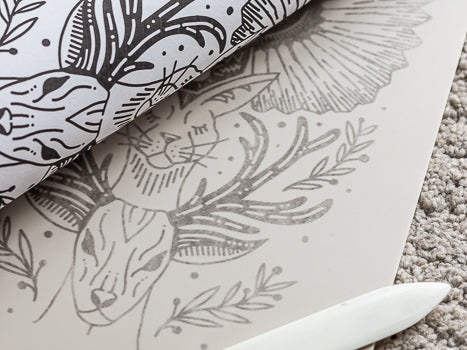DO WHAT YOU LOVE
My art journey started in 2019 when I quit my full-time job as a graphic designer. I felt more and more frustrated with client work and began questioning if this was the life I truly wanted. The Great Pan Studio was born.
Surrounded by the natural beauty of Salzkammergut's lakes, mountains, and diverse wildlife, I find endless inspiration for my work.
My perfect day starts with green tea and sunrise yoga. When I‘m not making art I like to bake, tidy up and organize, listen to podcasts or simply have a chilling time with my loved ones. 9

FAQs
Linocut is a relief printing process and is similar to woodcutting. It's basically an expanded version of a potato print 😉 See below for my process.
Diese Kennzeichnung ist eine gängige internationale Bezeichnung im Kunstdruckbereich. Sie beschreibt die Anzahl der Exemplare pro Edition. Zum Beispiel bedeutet „2/50“, dass es sich um den zweiten Linoldruck aus einer limitierten Edition von insgesamt 50 Exemplaren handelt. Diese Drucke sind einzigartig und limitiert.
- V.E. (Various Edition): Hier verwende ich verschiedene Tinten und Papiere pro Motiv bzw. Edition, um Vielfalt zu schaffen.
- O.E. (Open Edition): Das sind unlimitierte Editionen, bei denen ich so viele Exemplare drucken kann, wie ich möchte.
- A.P. (Artist Proof): Neben den nummerierten Linoldrucken erstelle ich auch einige Proofs, die entweder kleine Fehler aufweisen oder zusätzliche Exemplare für meine Sammlung sind.
Starting with the simplest tools and materials, I currently have the following equipment:
- Linoleum: Softcut 3mm
- Carving tools: Swiss Pfeil Tools
- Paper: handmade paper
- Color: mainly Caligo Safe Wash Relief Color
- Printing press: A4 Fome Etching Press and A2 Woodzilla Press
The name is derived from the Greek shepherd god Pan. In Greek mythology he is the protector of forests, meadows and nature.
Depicted as a hybrid of a human torso and a billy goat, names derived from him can even be found in our language: the pan flute and the word “panic”.
The world of gods and spirits has fascinated me for a long time - the mysticism behind it and the unknown. This is the magic of life.
And yes, the “studio” points to my vision of one day having a large, real studio full of creative possibilities! With shop, workshops and and and 🖤
If I have time, we are a good fit and I can help you implement your ideas: contact me. I am happy to help!
To me, leaving a lovable environment for future generations is crucial. So, I prioritize an ecological approach in my products and corporate philosophy. Therefore my packaging is plastic-free, I pay attention to natural materials and their origin.
Privately, as a second hand shopper, I aim to minimize waste and handle food responsibly.
How my linocut prints arise

1. Inspiration
My greatest inspiration is nature in all its forms and facets. I love studying the structure of individual leaves, observing birds and insects in detail and leafing through books on flora and fauna.

2. Design
Once I am full of ideas, I sit down with my iPad and start to draw. I usually leave the results for a few days before continuing again. The fresh, new perspective gives me new ideas about how I can optimize the finished design.

3. Transfer
There are many possibilities of transferring a motif onto the plate. For me the easiest way is to print it out using my inkjet printer and transfer it with lots of pressure using a folding bone. This creates a mirrored image on the softcut plate.

4. Carving
I usually start with the rough outer edges and work my way inside to the smaller details. I always use tools in different sizes and different profiles.

5. Coloring
I clean my workspace, prepare my press, paper and supplies and start rolling out the paint. Once it's nicely even, I roll it onto the carved lino plate. For the first time I see how the motif stands out - a magical moment!

6. Printing
I carefully place the paper onto the lino plate and put it through my printing press. If there are very fine details in the motif, I also like to use an old wooden spoon to apply additional pressure.

7. Drying
My apartment transforms into a drying room and finished prints can be found everywhere. With complex motifs or new materials there can be lots of misprints before I am satisfied with the result. Drying varies depending on color, temperature and humidity between 1-3 days.

8. Signing
After many, many hours, the final step in production follows: the finished prints are numbered, signed and stamped. Each print is therefore a unique piece of art with it's own characteristics.

9. Package & send
In the last step my lino prints are carefully packaged in order to send them to their designated new home.





